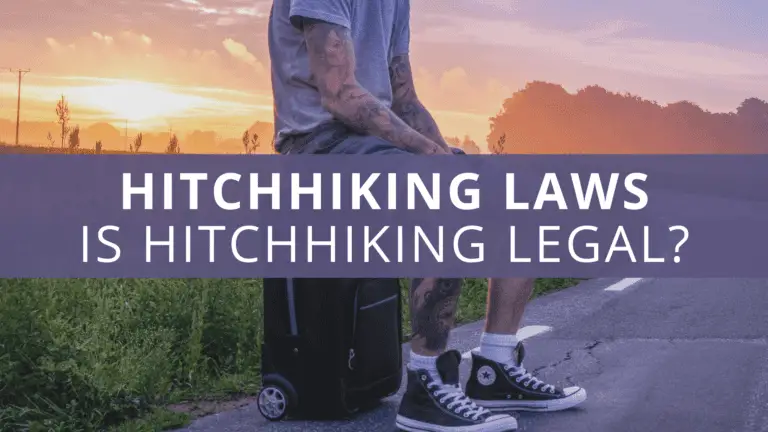Hitchhiking Laws: Is Hitchhiking Legal or Illegal in the US?
If you want to hitchhike or if you hitchhiker on the side of the road, you might be wondering, is hitchhiking legal in the United States?
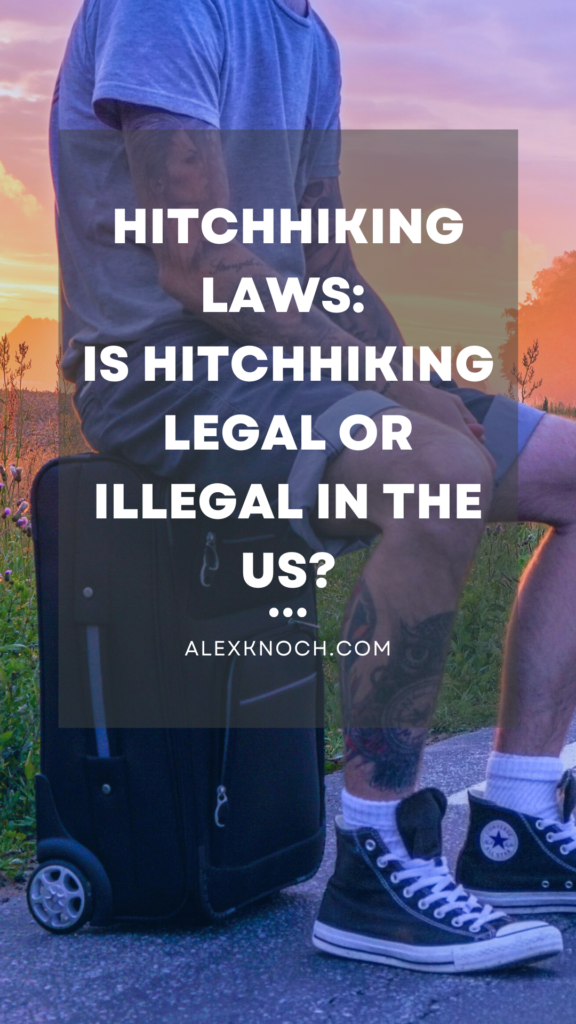
After hitchhiking through the United States and getting hundreds of rides, some of which were from the police, I’ve decided to put together this list of hitchhiking laws by state.
Most resources I’ve found online are outdated and I don’t want to be stuck on the side of the road asking myself, “Is hitchhiking legal here?” right as a cop pulls up.
Table of Contents
Is Hitchhiking Legal in the United States?
Yes, it is legal to hitchhike in the United States in 45 of the 50 states. It is illegal to hitchhike in Delaware, Idaho, New Jersey, Nevada, and Texas.
In addition to state laws, hitchhiking may be restricted in some areas by local or federal laws. Certain aspects of hitchhiking such as standing in the road or distracting drivers may also be illegal.
Generally, soliciting a ride is protected under free speech and only becomes illegal when you become a danger to yourself or others.
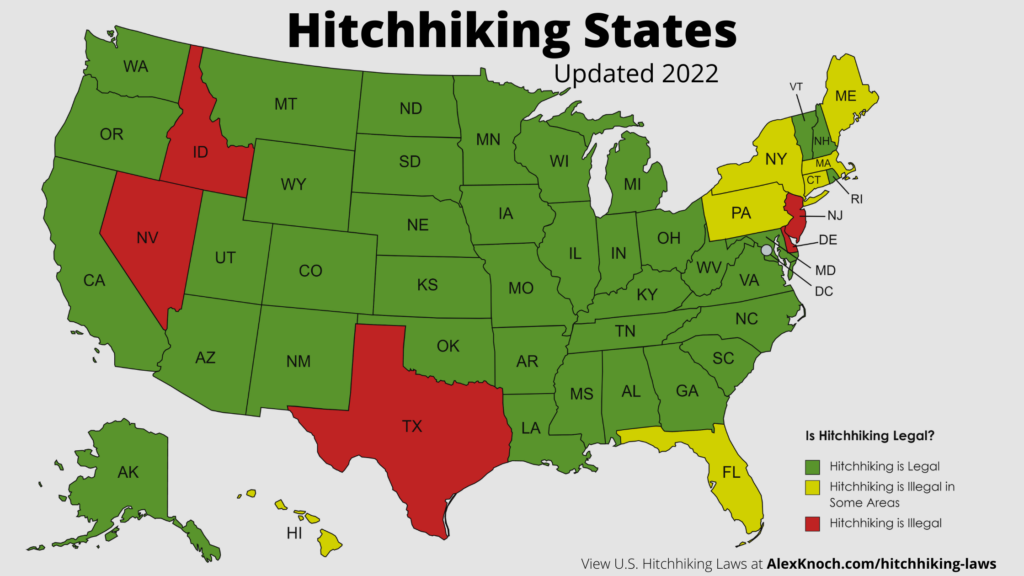
State Hitchhiking Laws
Every state has its own laws when it comes to hitchhiking so it can be difficult when trying to determine if hitchhiking is legal. Below I’ve listed all the laws pertaining to hitchhiking I could find for all 50 states.
Alabama
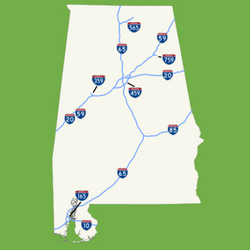
Is Hitchhiking Legal in Alabama?
Hitchhiking is legal in Alabama as long as you don’t stand in the roadway while soliciting a ride.
Alabama Hitchhiking Laws
Hitchhiking laws in Alabama are outlined in The Code of Alabama
- 32-5A-216 – Pedestrian soliciting rides or business or fishing.
- (a) No person shall stand in a roadway for the purpose of soliciting a ride.
- (b) No person shall stand on a highway for the purpose of soliciting employment, business, or contributions from the occupant of any vehicle, nor for the purpose of distributing any article, unless otherwise authorized by official permit of the governing body of the city or county having jurisdiction over the highway.
- (c) No person shall stand on or in proximity to a street or highway for the purpose of soliciting the watching or guarding of any vehicle while parked or about to be parked on a street or highway.
- (d) No person shall fish from a bridge, viaduct, or trestle, or the approaches thereto, within the State of Alabama, unless otherwise authorized by the governing body of the city or county having jurisdiction over the highway or from the State of Alabama in the case of state highways. The authorizing authority shall erect and maintain appropriate signs giving notice that fishing is allowed.
- 32-1-1.1 – DEFINITIONS
- (56) ROADWAY.
- That portion of a highway improved, designed or ordinarily used for vehicular travel, exclusive of the berm or shoulder.
- (56) ROADWAY.
Alaska

Is Hitchhiking Legal in Alaska?
Hitchhiking is legal in Alaska as long as you don’t solicit a ride in a way that distracts a driver’s attention and you don’t create an unreasonable risk of danger.
Alaska Hitchhiking Laws
Hitchhiking laws in Alaska are outlined in The Alaska Administrative Code
- 13 AAC 02.180 – Pedestrians soliciting rides or business
- No person may solicit a ride in a manner which distracts a driver’s attention, nor may a pedestrian upon a highway solicit employment, business, or contributions from the occupant of a vehicle.
- 13 AAC 02.175 – Pedestrians on highways
- (a) Where a sidewalk is provided and its use is practicable, a pedestrian may not walk upon an adjacent roadway except when crossing the roadway.
- (b) Where a sidewalk is not available, a pedestrian walking upon a highway shall walk on a shoulder as far as practicable from the edge of the roadway. Where neither a sidewalk nor a shoulder is available, a pedestrian walking on a highway shall walk as near as practicable to the outside edge of the highway and, if walking along a two-way roadway, shall walk only on the left side of the roadway. No pedestrian may walk on a controlled-access highway except in an emergency.
- (c) Repealed 6/28/79.
- (d) No pedestrian may be upon or along a roadway in such a manner as to create an unreasonable risk of danger to himself or interfere with the normal flow of traffic.
- (e) No pedestrian may sleep or loiter upon a highway or, without lawful permit, obstruct free passage upon a highway.
Arizona

Is Hitchhiking Legal in Arizona?
Hitchhiking is legal in Arizona as long as you do not stand in the roadway.
Arizona Hitchhiking Laws
Hitchhiking laws in Arizona are outlined in The Arizona Revised Statutes
- 28-796 – Pedestrian on roadways
- A. If sidewalks are provided, a pedestrian shall not walk along and on an adjacent roadway.
- B. If sidewalks are not provided, a pedestrian walking along and on a highway shall walk when practicable only on the left side of the roadway or its shoulder facing traffic that may approach from the opposite direction.
- C. A person shall not stand in a roadway for the purpose of soliciting a ride from the driver of a vehicle.
- 28-601. Definitions
- 22. “Roadway” means that portion of a highway that is improved, designed or ordinarily used for vehicular travel, exclusive of the berm or shoulder. If a highway includes two or more separate roadways, roadway refers to any such roadway separately but not to all such roadways collectively.
Arkansas
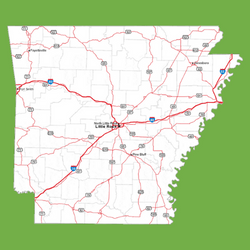
Is Hitchhiking Legal in Arkansas?
Hitchhiking is legal in Arkansas as long as you don’t stand in the roadway.
Arkansas Hitchhiking Laws
Hitchhiking laws in Arkansas are outlined in The Arkansas Code.
- 27-51-1205 – Soliciting rides.
- No person shall stand in a roadway for the purpose of soliciting a ride from the driver of any private vehicle.
- 27-49-212 – Definitions
- (b) “Roadway” means that portion of a highway improved, designed, or ordinarily used for vehicular travel.
California
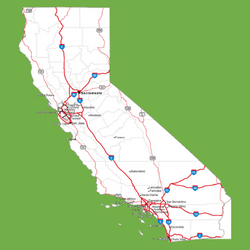
Is Hitchhiking Legal in California?
Hitchhiking is legal in California as long as you don’t stand in the roadway. Hitchhiking may be interpreted as soliciting a service, under which case it would be illegal under section 22520.5 but it is expressively covered under section 211957.
California Hitchhiking Laws
Hitchhiking laws in California are outlined in The California Vehicle Code.
- Section 211957
- No person shall stand in a roadway for the purpose of soliciting a ride from the driver of any vehicle.
- Section 530 – “Roadway” defined
- A “roadway” is that portion of a highway improved, designed, or ordinarily used for vehicular travel.
- Section 22520.5
- (a) No person shall solicit, display, sell, offer for sale, or otherwise vend or attempt to vend any merchandise or service while being wholly or partly within any of the following:
- (1) The right-of-way of any freeway, including any on ramp, off ramp, or roadway shoulder which lies within the right-of-way of the freeway.
- (2) Any roadway or adjacent shoulder within 500 feet of a freeway off ramp or on ramp.
- (3) Any sidewalk within 500 feet of a freeway off ramp or on ramp, when vending or attempting to vend to vehicular traffic.
- (b) Subdivision (a) does not apply to a roadside rest area or vista point located within a freeway right-of-way which is subject to Section 22520.6, to a tow truck or service vehicle rendering assistance to a disabled vehicle, or to a person issued a permit to vend upon the freeway pursuant to Section 670 of the Streets and Highways Code.
- (c) A violation of this section is an infraction. A second or subsequent conviction of a violation of this section is a misdemeanor.
- (a) No person shall solicit, display, sell, offer for sale, or otherwise vend or attempt to vend any merchandise or service while being wholly or partly within any of the following:
Colorado
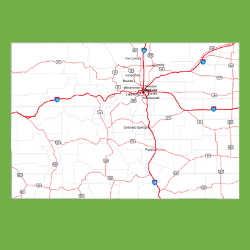
Is Hitchhiking Legal in Colorado?
Hitchhiking is legal in Colorado as long as you don’t solicit a ride on the highway but you can hitchhike from the entrance and exit of highways. You also can’t stand in the roadway and there must be enough room from cars to pullover safely.
Colorado Hitchhiking Laws
Hitchhiking laws in Colorado are outlined in The Colorado Revised Statutes
- 42-4-805 – Pedestrians walking or traveling in a wheelchair on highways.
- (2) No person shall stand in a roadway for the purpose of soliciting a ride from the driver of any private vehicle. For the purposes of this subsection (2), “roadway” means that portion of the road normally used by moving motor vehicle traffic.
- (3) It is unlawful for any person who is under the influence of alcohol or of any controlled substance, as defined in section 18-18-102 (5), C.R.S., or of any stupefying drug to walk or be upon that portion of any highway normally used by moving motor vehicle traffic.
- (4) This section applying to pedestrians shall also be applicable to riders of animals.
- (5) Any city or town may, by ordinance, regulate the use by pedestrians of streets and highways under its jurisdiction to the extent authorized under subsection (6) of this section and sections 42-4-110 and 42-4-111, but no ordinance regulating such use of streets and highways in a manner differing from this section shall be effective until official signs or devices giving notice thereof have been placed as required by section 42-4-111 (2).
- (6) No person shall solicit a ride on any highway included in the interstate system, as defined in section 43-2-101 (2), C.R.S., except at an entrance to or exit from such highway or at places specifically designated by the department of transportation; or, in an emergency affecting a vehicle or its operation, a driver or passenger of a disabled vehicle may solicit a ride on any highway.
- (7) Pedestrians shall only be picked up where there is adequate road space for vehicles to pull off and not endanger and impede the flow of traffic.
- (9) Any person who violates any provision of this section commits a class B traffic infraction.
Connecticut
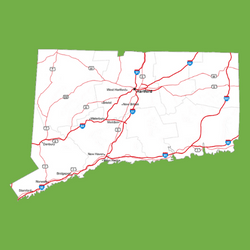
Is Hitchhiking Legal in Connecticut?
Hitchhiking is legal in most parts of Connecticut as long as you stay on the shoulder and off of the traveled portion of the highway.
It is illegal to hitchhike on any section that’s on the list of limited access highways. The list of limited access highways is updated yearly and includes small sections of many popular roads.
Connecticut Hitchhiking Laws
Hitchhiking laws in Connecticut are outlined in the Connecticut General Statutes
- Sec. 53-181. Soliciting rides in motor vehicles.
- Any person who, while on or within the limits of the traveled portion of any public highway, solicits a ride in a motor vehicle, other than a public service motor bus or taxicab, except in case of accident or emergency, shall be deemed to have committed an infraction and be fined thirty-five dollars, except that any person may, while on or within the shoulder portion of any public highway, except a limited access highway, solicit such a ride.
- Sec. 53-182. Use of highways by pedestrians.
- Any pedestrian who uses any street or highway negligently or recklessly or fails to obey the signal of any traffic officer, pedestrian control, sign, signal, marking or device or recklessly disregards his own safety or the safety of any person by the manner of his use of any street or highway shall be deemed to have committed an infraction and be fined not less than thirty-five dollars nor more than fifty dollars.
- Sec. 13b-27.
- The commissioner, with the advice and consent of the Governor and the Attorney General, may designate a proposed state highway, or portion thereof, as a limited access highway so as to allow access thereto only at highway intersections or at designated points, when in their opinion such limitation of access would be in the interest of public convenience, safety and necessity. With respect to such highway or portion thereof, the commissioner shall have and exercise all the powers and authority vested in him by statute concerning state highways.
Delaware
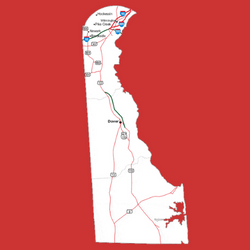
Is Hitchhiking Legal in Delaware?
Hitchhiking is illegal in Delaware unless you are on a road or driveway owned by a private person or school.
Delaware Hitchhiking Laws
Hitchhiking laws in Delaware are outlined in
- Section 4147 – PEDESTRIANS SOLICITING RIDES OR BUSINESS
- (c) No person shall stand in a highway for the purpose of soliciting a ride.
- (22) “Highway” means the entire width between boundary lines of every way or place of whatever nature open to the use of the public as a matter of right for purposes of vehicular travel, but does not include a road or driveway upon grounds owned by private persons, colleges, universities or other institutions.
Florida
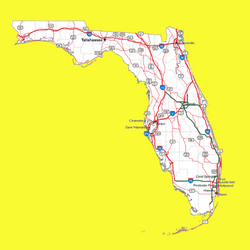
Is Hitchhiking Legal in Florida?
Hitchhiking is legal in most parts of Florida as long as you don’t stand on the paved roadway, you’re not near a bridge.
It is illegal to hitchhike in Monroe Country, Florida which includes The Florida Keys, Key Largo, and Key West.
Florida Hitchhiking Laws
Hitchhiking laws in Florida are outlined in the Florida Statutes.
- 316.130 – Pedestrians; traffic regulations.
- (5) No person shall stand in the portion of a roadway paved for vehicular traffic for the purpose of soliciting a ride, employment, or business from the occupant of any vehicle.
- (16) No pedestrian shall enter or remain upon any bridge or approach thereto beyond the bridge signal, gate, or barrier after a bridge operation signal indication has been given. No pedestrian shall pass through, around, over, or under any crossing gate or barrier at a railroad grade crossing or bridge while such gate or barrier is closed or is being opened or closed.
- (18) No pedestrian shall walk upon a limited access facility or a ramp connecting a limited access facility to any other street or highway; however, this subsection does not apply to maintenance personnel of any governmental subdivision.
- (19) A violation of this section is a noncriminal traffic infraction, punishable pursuant to chapter 318 as either a pedestrian violation or, if the infraction resulted from the operation of a vehicle, as a moving violation.
Monroe County Hitchhiking Laws
Hitchhiking laws in Monroe Country are outline in their Code of Ordinances
- Sec. 25-3. – Hitchhiking.
- (a)Definitions. The following words, terms and phrases, when used in this section, shall have the meanings ascribed to them in this subsection, except where the context clearly indicates a different meaning:
- Hitchhike, solicit or attempt to solicit a ride from the driver of any vehicle means any overt act on the part of an individual indicating that he is seeking to have a passing vehicle stop for the purpose of obtaining a ride from the driver thereof.
- Overt act includes and shall be limited to the waving of one or both arms or gesturing with the arms or hands or body in such a manner so as to attract the attention of passing motorists in an attempt to have them stop their vehicle and give such person a ride. The overt act shall also include the wearing or use of signs large enough to be read by passing motorists indicating that the individual wishes to be transported. No other overt acts shall constitute an element of the offense prohibited by this section. Only the person exhibiting such overt act shall be in violation of this section, and this section shall not apply to any person merely because he happens to be present near the person who is exhibiting the overt act.
- (b)Prohibited. It shall be unlawful for any person to stand or position himself upon any county, state or federal street, highway or road right-of-way lying within the unincorporated areas of the county, and hitchhike, solicit or attempt to solicit a ride from the driver of any vehicle.
- (c)Exceptions. This section shall not apply to instances involving a disabled vehicle that due to mechanical or other reason is incapable of operation in a safe manner, where the driver of such vehicle exits the vehicle and either lifts the hood or places a handkerchief or rag or similar distress signal on such vehicle indicating that such vehicle is disabled. Nor shall this section apply if such driver of such disabled vehicle hitchhikes, solicits or attempts to solicit assistance from passing motorists so long as he shall do so in the immediate 20-foot vicinity of the disabled vehicle. This section shall likewise not apply to any instance of valid public or private emergency wherein the health, safety and physical safety of a person is in jeopardy and such person is in immediate need of medical attention, police or fire protection.
- (a)Definitions. The following words, terms and phrases, when used in this section, shall have the meanings ascribed to them in this subsection, except where the context clearly indicates a different meaning:
Georgia
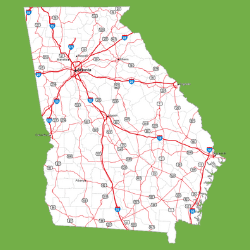
Is Hitchhiking Legal in Georgia?
Hitchhiking is legal in Georgia as long as you’re not standing on the roadway or near a bridge.
Georgia Hitchhiking Laws
Hitchhiking laws in Georgia are outlined in the Georgia Code.
- 40-6-95. Pedestrian under influence of alcohol or drug
- A person who is under the influence of intoxicating liquor or any drug to a degree which renders him a hazard shall not walk or be upon any roadway or the shoulder of any roadway. Violation of this Code section is a misdemeanor and is punishable upon conviction by a fine not to exceed $500.00.
- 40-6-96. Pedestrians on or along roadway
- (a) As used in this Code section, the term “pedestrian” means any person afoot and shall include, without limitation, persons standing, walking, jogging, running, or otherwise on foot.
- (b) Where a sidewalk is provided, it shall be unlawful for any pedestrian to stand or stride along and upon an adjacent roadway unless there is no motor vehicle traveling within 1,000 feet of such pedestrian on such roadway or the available sidewalk presents an imminent threat of bodily injury to such pedestrian.
- (c) Where a sidewalk is not provided but a shoulder is available, any pedestrian standing or striding along and upon a highway shall stand or stride only on the shoulder, as far as practicable from the edge of the roadway.
- (d) Where neither a sidewalk nor a shoulder is available, any pedestrian standing or striding along and upon a highway shall stand or stride as near as practicable to an outside edge of the roadway, and, if on a two-lane roadway, shall stand or stride only on the left side of the roadway.
- (e) Except as otherwise provided in this chapter, any pedestrian upon a roadway shall yield the right of way to all vehicles upon the roadway.
- (f) No pedestrian shall enter or remain upon any bridge or approach thereto beyond the bridge signal, gate, or barrier after a bridge operation signal indication has been given.
- (g) No pedestrian shall pass through, around, over, or under any crossing gate or barrier at a railroad grade crossing or bridge while such gate or barrier is closed or is being opened or closed.
- 40-6-97. Pedestrians soliciting
- (a) No person shall stand in a roadway for the purpose of soliciting a ride.
- (b) Except as provided in Code Section 40-6-97.1, no person shall stand on a highway for the purpose of soliciting employment, business, or contributions from the occupant of any vehicle.
- (c) No person shall stand on or in proximity to a street or highway for the purpose of soliciting the watching or guarding of any vehicle while parked or about to be parked on a street or highway.
- 40-1-1. Definitions
- (53) “Roadway” means that portion of a highway improved, designed, or ordinarily used for vehicular travel, exclusive of the berm or shoulder. In the event a highway includes two or more separate roadways, the term “roadway” shall refer to any such roadway separately, but not to all such roadways collectively.
Hawaii
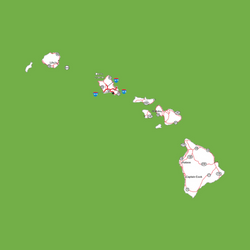
Is Hitchhiking Legal in Hawaii?
Hitchhiking is legal in Hawaii, Honolulu, and Kauai counties and is illegal on the island and county of Maui. Hawaii state law specifies that hitchhiking is illegal unless stated otherwise in a county ordinance.
Hawaii, Honolulu, and Kauai counties all have ordances making hitchhiking legal as long as you don’t stand in the roadway.
Hawaii Hitchhiking Laws
Hitchhiking state laws in Hawaii are outlined in the Hawaii Revised Statutes.
- 291C-77 Pedestrians soliciting rides, business or attention of motorist.
- (a) Except as otherwise provided by county ordinance, no person shall stand in, walk along, or otherwise occupy a portion of a highway for the purpose of soliciting a ride, employment, business, or contributions from the occupant of any vehicle.
- 291C-1 Definitions.
- As used in this chapter: Highway means the entire width between the boundary lines of every way publicly maintained and those private streets, as defined in section 46-16, over which the application of this chapter has been extended by ordinance, when any part thereof is open to the use of the public for purposes of vehicular travel.
Hawaii County
Hitchhiking laws in Hawaii County are outlined in the Hawaiʻi County Code
- 24-249 Pedestrians soliciting rides or business prohibited
- (a) No person shall stand in a roadway for the purpose of soliciting a ride, employment, or business from the occupant of any vehicle.
- 24-252.
- Highway railings; prohibited acts. No person shall sit, stand, or walk or aid or assist any other person to sit, stand, or walk upon the railing of any highway bridge, overpass or guardrail.
- 24-3 Definitions
- (35) “Roadway” means that portion of a highway improved, designed or ordinarily used for vehicular travel, exclusive of the berm or shoulder.
Honolulu County
Hitchhiking laws in Honolulu County are outlined in The Revised Ordinances of Honolulu
- 15-17.4 Hitchhiking
- The solicitation of free rides (hitchhiking) shall be permitted at any official bus stop of the city and county or in any open area where there are no official bus stops within a reasonable distance; provided, however, that the person soliciting rides shall not stand for the purpose of such solicitation on the roadway; and provided further, that no person shall attempt to intimidate, threaten or otherwise annoy passing motorists while so engaged in hitchhiking. Any person violating this section shall be issued a citation according to the procedures specified in Article 26 of this chapter unless such person refuses to provide suitable identification, in which case the arresting officer shall take the person into custody according to the prescribed procedure for physical arrest in HRS Chapter 803.
- Sec. 15-17.6 Sitting, standing or walking on railings of highway bridges or overpasses.
- No person shall sit, stand or walk, or aid or assist any other person to sit, stand or walk upon the railing of any highway bridge or overpass in the City and County of Honolulu.
Kauai County
Hitchhiking laws in Kauai County are outlined in the Kauaʻi County Code
- Sec. 16-15.2 Pedestrians Soliciting Rides.
- No person shall stand in the roadway for the purpose of soliciting a ride, employment or business from the occupant of any vehicle but in no event shall the person solicit a ride, employment or business in an area where the vehicle stopping shall impede or endanger the normal flow of traffic.
- Sec. 16-1.3 Definitions.
- “Roadway” or “Road” means that portion of a highway improved, designed, or ordinarily used for vehicular travel, exclusive of the berm or shoulder. In the event a highway includes two (2) or more separate roadways the term roadway as used herein refers to any such roadway separately but not to all such roadways collectively.
Idaho
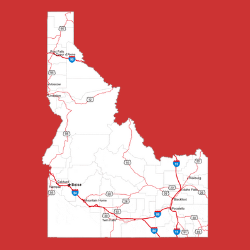
Is Hitchhiking Legal in Idaho?
Hitchhiking is illegal in Idaho.
Idaho Hitchhiking Laws
Hitchhiking laws in Idaho are outlined in the Idaho Statutes.
- 49-709 PEDESTRIANS SOLICITING RIDES OR BUSINESS.
- (1) No person shall stand on a highway for the purpose of soliciting a ride.
- (5) “Highways” mean roads, streets, alleys and bridges laid out or established for the public or dedicated or abandoned to the public. Highways shall include necessary culverts, sluices, drains, ditches, waterways, embankments, retaining walls, bridges, tunnels, grade separation structures, roadside improvements, adjacent lands or interests lawfully acquired, pedestrian facilities, and any other structures, works or fixtures incidental to the preservation or improvement of the highways.
Illinois
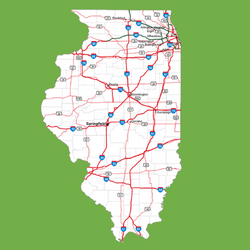
Is Hitchhiking Legal in Illinois?
Hitchhiking is legal in Illinois as long as you stay on the shoulder of the road and you don’t stand in the road.
Illinois Hitchhiking Laws
Hitchhiking laws in Illinois are outlined in the Illinois Compiled Statutes.
- Sec. 11-1006. Pedestrians soliciting rides or business.
- No person shall stand in a roadway for the purpose of soliciting a ride from the driver of any vehicle.
- Sec. 1-179. Roadway.
- That portion of a highway improved, designed or ordinarily used for vehicular travel, exclusive of the berm or shoulder.
Indiana
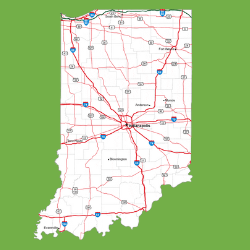
Is Hitchhiking Legal in Indiana?
Hitchhiking is legal in Indiana as long as you don’t stand in the roadway.
Indiana Hitchhiking Laws
Hitchhiking laws in Indiana are outlined in the Indiana Code.
- 9-21-17-16 Solicitation of rides; restrictions; emergency
- A person may not stand in a roadway for the purpose of soliciting a ride from a person who drives a vehicle unless the person soliciting a ride is faced with an emergency on the roadway, in which case the person may secure a ride to obtain assistance.
- IC 9-13-2-157 “Roadway”
- (a) Except as provided in subsection (b), “roadway” means that part of a highway improved, designed, or ordinarily used for vehicular travel.
- (b) As used in IC 9-21-12-13, “roadway” means the part of a highway that is improved, designed, or ordinarily used for vehicular travel. The term does not include the sidewalk, berm, or shoulder, even if the sidewalk, berm, or shoulder is used by persons riding bicycles or other human powered vehicles.
Iowa
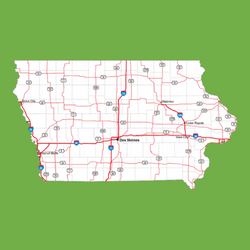
Is Hitchhiking Legal in Iowa?
Hitchhiking is legal in Iowa as long as you don’t stand on a portion of the road that is used for vehicles.
Iowa Hitchhiking Laws
Hitchhiking laws in Iowa are outlined in the Iowa Code.
- 321.331 Pedestrians soliciting rides.
- 1. No person shall stand in a roadway for the purpose of soliciting a ride from the driver of any private vehicle.
- 2. Nothing in this section or this chapter shall be construed so as to prevent any pedestrian from standing on that portion of the highway or roadway, not ordinarily used for vehicular traffic, for the purpose of soliciting a ride from the driver of any vehicle.
Kansas
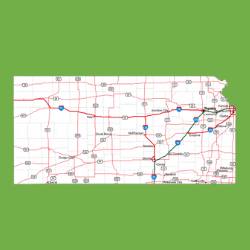
Is Hitchhiking Legal in Kansas?
Hitchhiking is legal in Kansas as long as you don’t stand on the roadway and instead stand on the shoulder or berm.
Kansas Hitchhiking Laws
Hitchhiking laws in Kansas are outlined in the Kansas Statutes.
- 8-1538. Soliciting rides, business or contributions
- (a) No person shall stand in a roadway for the purpose of soliciting a ride.
- 8-1459. “Roadway” defined.
- “Roadway” means that portion of a highway improved, designed, or ordinarily used for vehicular travel, exclusive of the berm or shoulder. In the event a highway includes two (2) or more separate roadways the term “roadway” as used herein shall refer to any such roadway separately but not to all such roadways collectively.
Kentucky
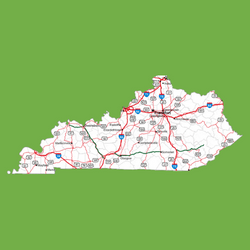
Is Hitchhiking Legal in Kentucky?
Hitchhiking is legal in Kentucky as long as you stay on the shoulder or berm and you don’t stand in the roadway.
Kentucky Hitchhiking Laws
Hitchhiking laws in Kentucky are outlined in the Kentucky Revised Statutes.
- 189.570 Pedestrians
- (16) A pedestrian who is under the influence of alcohol or any kind of drug to a degree which renders himself a hazard shall not walk or be upon a highway except on a sidewalk.
- (17) No pedestrian shall enter or remain upon any bridge or approach thereto beyond the bridge signal, gate, or barrier, after a bridge operation signal indication has been given.
- (18) No pedestrian shall pass through, around, over, or under any crossing gate or barrier at a railroad grade crossing or bridge while such gate or barrier is closed or is being opened or closed
- (19) No person shall stand in a roadway for the purpose of soliciting a ride.
- 189.010 Definitions
- (10) Roadway means that portion of a highway improved, designed, or ordinarily used for vehicular travel, exclusive of the shoulder or berm.
Louisiana
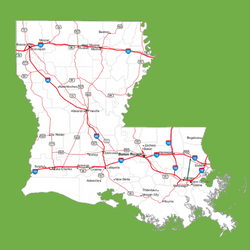
Is Hitchhiking Legal in Louisana?
Hitchhiking is legal in Louisana as long as you stay on the berm or should and you don’t stand on the portion of the road normally used for vehicles.
Louisiana Hitchhiking Laws
Hitchhiking laws in Louisana are outlined in the Louisiana Revised Statutes.
- 32.218 – Pedestrians soliciting rides or business
- A. No person shall stand on a public roadway for the purpose of soliciting a ride, employment, or business from the occupant of any vehicle.
- 32.1 Definitions
- (59) “Roadway” means that portion of a highway improved, designed, or ordinarily used for vehicular traffic, exclusive of the berm or shoulder.
Maine
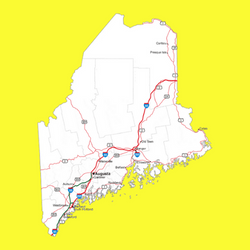
Is Hitchhiking Legal in Maine?
Hitchhiking is illegal in Maine on the Turnpike and areas where signs have been posted. Hitchhiking is legal in all other areas as long as you stay off of the traveled portion of the road.
Maine Hitchhiking Laws
Hitchhiking laws in Maine are outlined in the Maine Revised Statutes.
Title 29-A 2110 Hitchhiking Forbidden
- Definition. As used in this section, “hitchhike” means to endeavor by words, gestures or otherwise to beg, invite or secure transportation in a motor vehicle not engaged in carrying passengers for hire, unless the hitchhiker is known to the driver or a passenger.
- Violation. A person commits a traffic infraction if that person hitchhikes on:
(a) The traveled portion of a public way
(b) A limited access highway, including but not limited to the Maine Turnpike; or
(c) Any portion of a public way during the nighttime. - Exception. This section does not prohibit solicitation of aid in the event of an accident or by persons who are sick or seeking assistance for the sick, if the sickness is bona fide and an emergency exists.
- Regulation. A municipality may regulate or prohibit hitchhiking on a public way by ordinance. The Department of Transportation may regulate or prohibit hitchhiking on a state or state aid highway in the interest of safety at those locations where accidents may be a problem, limited visibility exists or severe traffic conflicts or other safety factors may occur.
- Posting. An area in which hitchhiking has been regulated or prohibited must be clearly identified by posted signs.
- Forfeitures. For a violation of subsection 2, a forfeiture not to exceed $50 may be adjudged.
Maryland
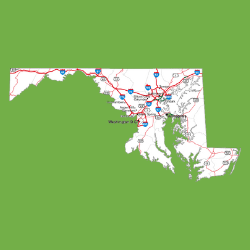
Is Hitchhiking Legal in Maryland?
Hitchhiking is legal in Maryland as long as you stand on the sidewalk, berm, or shoulder.
Maryland Hitchhiking Laws
Hitchhiking laws in Maryland are outlined in the Maryland Statutes
- 21-507. Certain activities by pedestrians prohibited
- (a) Soliciting rides, employment, or business.- Except for the occupant of a disabled vehicle who seeks the aid of another vehicle, a person may not stand in a roadway to solicit a ride, employment, or business from the occupant of any vehicle.
- Appendix B. Definitions:
- Roadway: That portion of a highway improved, designed, or ordinarily used for vehicular travel and parking lanes, but exclusive of the sidewalk, berm, or shoulder even though such sidewalk, berm, or shoulder is used by persons riding bicycles or other human-powered vehicles.
Massachusetts
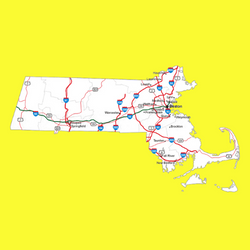
Is Hitchhiking Legal in Massachusetts?
Hitchhiking is illegal in Massachusetts while you are on or within view of the turnpike. Hitchhiking near the turnpike may result in an arrest and a fine of up to $50.
Hitchhiking is legal in the rest of Massachusetts as long as you aren’t standing on any part of the improved road so it’s best to stay on the grass or shoulder.
Massachusetts Hitchhiking Laws
Hitchhiking laws in Massachusetts are outlined in the General Laws of Massachusetts.
- 720 CMR
- 9.09
- (6) Pedestrians Soliciting Rides or Business. No person shall stand in a roadway for the purpose of soliciting a ride, employment or business from the operator or occupant of any vehicle without the written permission of the board or officer having control over such roadway or higway.
- 5.102 Definitions
- Roadway: That portion of a higway between regularly established curb lines, or that part, exclusive of shoulders, improved and intended to be used for vehicular traffic.
- 9.09
- 730 CMR
- 7.05: Massachusetts Turnpike Authority
- (8)No individual may engage in the solicitation of a ride, commonly known as “hitchhiking,” on a way. No person shall loiter in or about a way for the purpose of “hitchhiking” or for any other purpose
- 7.05: Massachusetts Turnpike Authority
- Chapter 81A the Massachusetts Turnpike Authority and the Metropolitan Highway System. –
- Section 1 Massachusetts Turnpike Authority; constitution as public instrumentality
- Whoever, for the purpose of soliciting a ride on the turnpike or the metropolitan highway system, displays a sign, signals a moving vehicle, causes the stopping of a vehicle or stands on property of the authority in view of a ramp or roadway of the turnpike may be arrested without a warrant and shall be punished by a fine of not more than fifty dollars.
- Section 1 Massachusetts Turnpike Authority; constitution as public instrumentality
Michigan
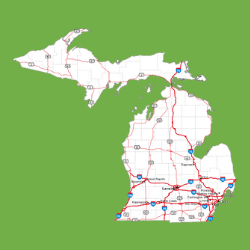
Is Hitchhiking Legal in Michigan?
Hitchhiking is legal in Michigan as long as you stay off of the improved portion of the road, so stay just remember to stay on the grass or shoulder.
Michigan Hitchhiking Laws
Hitchhiking laws in Michigan are outlined in the Michigan Compiled Laws.
- 28.1713 – Rule 713. Pedestrians; soliciting ride, employment, or business in roadway prohibited
- (1) A person shall not stand in a roadway for the purpose of soliciting a ride, employment, or business from the occupant of any vehicle.
- (2) A person who violates this rule is responsible for a civil infraction.
- 257.55 “Roadway” defined.
- “Roadway” means that portion of a highway improved, designed, or ordinarily used for vehicular travel. In the event a highway includes 2 or more separate roadways, the term “roadway”, as used herein, shall refer to any such roadway separately, but not to all such roadways collectively.
Minnesota
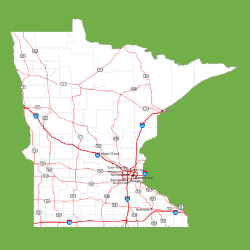
Is Hitchhiking Legal in Minnesota?
Hitchhiking is legal in Minnesota as long as you stay off of the road and stay on the shoulder or sidewalk.
Minnesota Hitchhiking Laws
Hitchhiking laws in Minnesota are outlined in the Minnesota Statutes.
- 169.22 Hitchhiking; solicitation of business.
- Subdivision 1. Soliciting ride.
- No person shall stand in a roadway for the purpose of soliciting a ride from the driver of any private vehicle.
- Subd. 2. Soliciting employment, business, or contributions.
- No person shall stand on a roadway for the purpose of soliciting employment, business, or contributions from the occupant of any vehicle.
- Subdivision 1. Soliciting ride.
- 169.011 DEFINITIONS.
- 68. Roadway.
- “Roadway” means that portion of a highway improved, designed, or ordinarily used for vehicular travel, exclusive of the sidewalk or shoulder. During periods when the commissioner allows the use of dynamic shoulder lanes as defined in subdivision 25, roadway includes that shoulder..
- 68. Roadway.
Mississippi
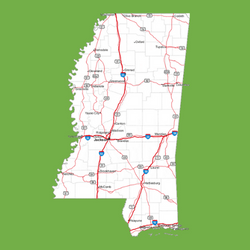
Is Hitchhiking Legal in Mississippi?
Hitchhiking is legal in Mississippi as long as you stay on the outside of the shoulder lines. These are typically the white solid lines on either side of the road.
Mississippi Hitchhiking Laws
Hitchhiking laws in Mississippi are outlined in the Mississippi Code.
- 63-3-1109. Solicitation of rides by pedestrians.
- No person shall stand in a roadway for the purpose of soliciting a ride from the driver of any private vehicle.
- Section 101.02 Definitions:
- “Roadway” All surface portions of the roadway between shoulder lines.
Missouri
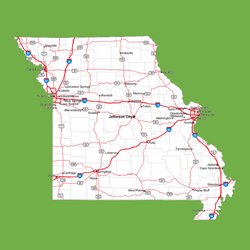
Is Hitchhiking Legal in Missouri?
Hitchhiking is legal in Missouri except for in the city of Mexico, Missouri. Pedestrians on highways are unregulated in Missouri.
Missouri Hitchhiking Laws
Hitchhiking laws for the state of Missouri do not exist. Pedestrians in Missouri are allowed on the highway and are allowed to solicit rides provided that the local laws don’t prohibit it.
The only city that is known to prohibit hitchhiking in Missouri is the city of Mexico.
Mexico, Missouri Hitchhiking Laws
- Sec. 10-22. – Hitchhiking; standing on street to solicit employment or business.
- (a) No person in this city shall hitchhike, thumb rides or go upon the public streets and highways for the purpose of soliciting free transportation.
Montana
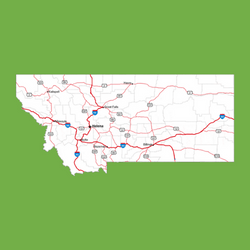
Is Hitchhiking Legal in Montana?
Hitchhiking is legal in Montana as long as you don’t stand on the roadway or paved shoulder.
Montana Hitchhiking Laws
Hitchhiking laws in Montana are outlined in the Montana Code.
- 61-8-507. Pedestrian soliciting rides, business, or contributions.
- (1) A person may not stand on a roadway for the purpose of soliciting a ride.
- (2) A person may not stand on a highway for the purpose of soliciting employment, business, or contributions from the occupant of a vehicle unless the solicitation is authorized by the proper jurisdictional authority.
- 61-8-102. Uniformity of interpretation — definitions.
- (v) “Roadway” means the portion of a highway that is improved, designed, or ordinarily used for vehicular travel, including the paved shoulder.
Nebraska
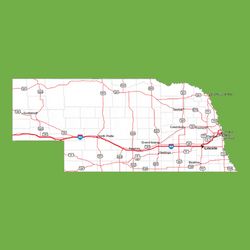
Is Hitchhiking Legal in Nebraska?
Hitchhiking is legal in Nebraska as long as you stand on the berm or shoulder.
Nebraska Hitchhiking Laws
Hitchhiking laws in Nebraska are outlined in the Nebraska Revised Statutes.
- 60-6,157. Pedestrians soliciting rides or business
- (1) Except as otherwise provided in subsection (3) of this section, no person shall stand in a roadway for the purpose of soliciting a ride, employment, contributions, or business from the occupant of any vehicle.
- (2) No person shall stand on or in proximity to a highway for the purposes of soliciting the watching or guarding of any vehicle while parked or about to be parked on a highway.
- (3)(a) Any municipality may, by ordinance, allow pedestrians over the age of eighteen to enter one or more roadways, except roadways that are part of the state highway system, at specified times and locations and approach vehicles when stopped by traffic control devices or traffic control signals for the purpose of soliciting contributions which are to be devoted to charitable or community betterment purposes.
- (b) Any ordinance enacted pursuant to this subsection shall be a general ordinance which shall not exclude or give preference to any individual or the members of any organization, association, or group. Any ordinance whose terms or provisions do not strictly comply with this subsection is void.
- 60-656.
- Roadway, defined.
- Roadway shall mean that portion of a highway improved, designed, or ordinarily used for vehicular travel, exclusive of the berm or shoulder. If a highway includes two or more separate roadways, the term roadway shall refer to any such roadway separately but not to all such roadways collectively.
- Roadway, defined.
Nevada
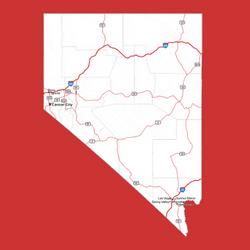
Is Hitchhiking Legal in Nevada?
Hitchhiking is illegal in Nevada. Nevada statutes prohibit hitchhiking on any highway and the state of Nevada defines “Highway” as any public road used for vehicular traffic and includes the entire area between the boundary lines.
Nevada Hitchhiking Laws
Hitchhiking laws in Nevada are outlined in the Nevada Revised Statutes.
- NRS 484B.297 Walking along and upon highways;
- 1. Except as otherwise provided in subsection 6, where sidewalks are provided, it is unlawful for any pedestrian to walk along and upon an adjacent highway.
- 2. Except as otherwise provided in subsection 6, pedestrians walking along highways where sidewalks are not provided shall walk on the left side of those highways facing the approaching traffic.
- 3. A person shall not stand in a highway to solicit a ride or any business from the driver or any occupant of a vehicle. A person shall not, without a permit issued pursuant to NRS 244.3555 or 268.423, solicit any contribution from the driver or any occupant of a vehicle.
- 4. It is unlawful for any pedestrian who is under the influence of intoxicating liquors or any narcotic or stupefying drug to be within the traveled portion of any highway.
- 7. A person who violates the provisions of this section is guilty of a misdemeanor.
- NRS 484A.095 “Highway” defined.
- “Highway” means the entire width between the boundary lines of every way dedicated to a public authority when any part of the way is open to the use of the public for purposes of vehicular traffic, whether or not the public authority is maintaining the way.
New Hampshire
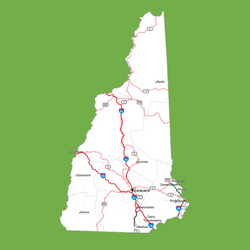
Is Hitchhiking Legal in New Hampshire?
Hitchhiking is legal in New Hampshire. New Hampshire is one of the only states to explicitly state that hitchhiking is legal as long as you’re not standing on the paved portion of the road.
New Hampshire Hitchhiking Laws
Hitchhiking laws in New Hampshire are outlined in their Revised Statutes.
- 265:40 Pedestrians Soliciting Rides or Business.
- I. No person shall stand on the travelled portion of a roadway for the purpose of soliciting a ride, employment, business or contributions from the occupant of any vehicle.
- II. No person shall stand on or in proximity to the traveled portion of a street or way for the purpose of soliciting the watching or guarding of any vehicle while parked or about to be parked on a street or way.
- III. It shall be lawful for any person to hitchhike or solicit a ride from the occupant of any vehicle upon any road or way, or limited access road and highway provided that the individual is not, when so doing, standing on the paved portion of the road or way.
- IV. No person shall signal a moving vehicle or stop a vehicle on any public way in order to solicit or sell a ticket of admission to an entertainment or sports event.
New Jersey
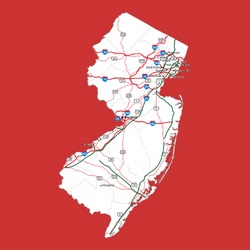
Is Hitchhiking Legal in New Jersey?
Hitchhiking is illegal in New Jersey. New Jersey statutes prohibit hitchhiking on any highway and the state of New Jersey defines “Highway” as any public road used for vehicular traffic and includes the entire area between the boundary lines.
New Jersey Hitchhiking Laws
Hitchhiking laws in New Jersey are outlined in the New Jersey Revised Statutes.
- 39:4-59. Begging rides prohibited
- No person shall stand in a highway for the purpose of or while soliciting a ride from the operator of any vehicle other than an omnibus or a street car.
- 39:1-1 Words and phrases defined.
- “Highway” means the entire width between the boundary lines of every way publicly maintained when any part thereof is open to the use of the public for purposes of vehicular travel.
New Mexico
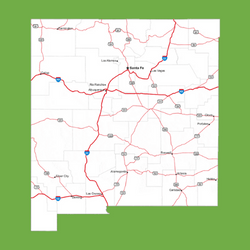
Is Hitchhiking Legal in New Mexico?
Hitchhiking is legal in New Mexico.
New Mexico Hitchhiking Laws
Hitchhiking laws in New Mexico are outlined in the New Mexico Statutes.
- 66-7-340. Pedestrians soliciting rides or business.
- A. No person shall stand in a roadway for the purpose of soliciting a ride, employment or business from the occupant of any vehicle.
- B. No person shall stand on or in proximity to a street or highway for the purpose of soliciting the watching or guarding of any vehicle while parked or about to be parked on a street or highway.
- 66-7-339. Pedestrians on roadways.
- A. Where sidewalks are provided, it is unlawful for a pedestrian to walk along and upon an adjacent roadway.
- B. Where sidewalks are not provided, a pedestrian walking along and upon a highway shall, when practicable, walk only on the left side of the roadway or its shoulder facing traffic that may approach from the opposite direction.
- C. A person who violates the provisions of this section is guilty of a penalty assessment misdemeanor.
- 66-1-4.15. Definitions.
- P. “roadway” means that portion of a street or highway improved, designed or ordinarily used for vehicular travel, exclusive of the berm or shoulder; when a highway includes two or more separate roadways, the term “roadway” refers to each roadway separately but not to all of the roadways collectively.
New York
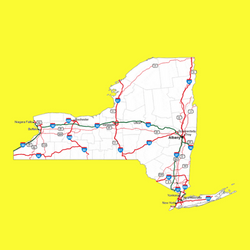
Is Hitchhiking Legal in New York?
Hitchhiking is illegal in New York on any part of the Thruway system including the on-ramp and service area. It is also illegal to stand in the roadway while soliciting a ride. The map below, from the Thruway Authority, highlights the Thruway system where hitchhiking is illegal in New York.
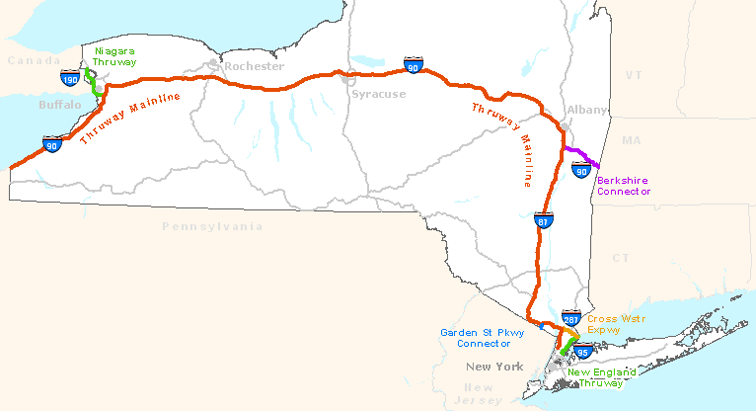
New York Hitchhiking Laws
Hitchhiking laws in New York are outlined in the Consolidated Laws of New York.
- §1157. Pedestrians soliciting rides, or business.
- (a) No person shall stand in a roadway for the purpose of soliciting a ride or to solicit from or sell to an occupant of any vehicle.
- §140. Roadway.
- That portion of a highway improved, designed, marked, or ordinarily used for vehicular travel, exclusive of the shoulder and slope.
- 102.4 Hitchhiking; loitering.
- The solicitation of a ride, commonly known as hitchhiking, or stopping any vehicle for the purpose of picking up or discharging a hitchhiker, on any portion of the Thruway system, including toll plazas, is prohibited. Loitering in or about the toll plazas or any other portion of the Thruway system, for the purpose of hitchhiking or for any other purpose, is prohibited.
North Carolina
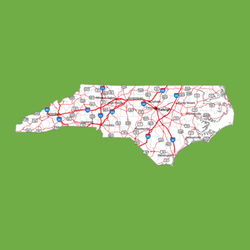
Is Hitchhiking Legal in North Carolina?
Hitchhiking is legal in North Carolina as long as you stand on the shoulder of the road.
North Carolina Hitchhiking Laws
Hitchhiking laws in North Carolina are outlined in their General Statutes.
- 20174.1. Standing, sitting or lying upon highways or streets prohibited.
- (a) No person shall willfully stand, sit, or lie upon the highway or street in such a manner as to impede the regular flow of traffic.
- (b) Violation of this section is a Class 2 misdemeanor.
- 20-175. Pedestrians soliciting rides, employment, business or funds upon highways or streets.
- (a) No person shall stand in any portion of the State highways, except upon the shoulders thereof, for the purpose of soliciting a ride from the driver of any motor vehicle.
North Dakota
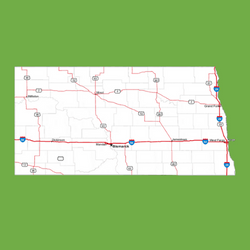
Is Hitchhiking Legal in North Dakota?
Hitchhiking is legal in North Dakota as long as you stay on the berm or shoulder.
North Dakota Hitchhiking Laws
Hitchhiking laws in North Dakota are outlined in the North Dakota Century Code.
North Dakota Code 39-10-34 – Pedestrian soliciting ride or business
- 39-10-33. Pedestrian on roadway.
- 1. Where a sidewalk is provided and its use is practicable, it is unlawful for any pedestrian to walk along and upon an adjacent roadway.
- 2. Where a sidewalk is not available, any pedestrian walking along and upon a highway shall walk only on a shoulder, as far as practicable from the edge of the roadway.
- 3. Where neither a sidewalk nor a shoulder is available, any pedestrian walking along and upon a highway shall walk as near as practicable to an outside edge of the roadway, and, if on a two-way roadway, shall walk only on the left side of the roadway.
- 4. Except as otherwise provided for in this chapter, any pedestrian upon a roadway shall yield the right of way to all vehicles upon the roadway.
- 39-10-33.4. Pedestrian under influence of alcohol or drugs.
- A pedestrian who is under the influence of alcohol or any drug to a degree which renders the pedestrian a hazard may not walk or be upon a roadway.
- 39-10-34. Pedestrian soliciting ride or business.
- 1. No person may stand in a roadway for the purpose of soliciting a ride.
- 2. No person may stand in a roadway for the purpose of soliciting employment, business, or contributions from the occupant of any vehicle.
- 3. No person may stand on or in proximity to a street or highway for the purpose of soliciting the watching or guarding of any vehicle while parked or about to be parked on a street or highway.
- 39-01-01. Definitions
- 75. “Roadway” means that portion of a highway improved, designed, or ordinarily used for vehicular travel, exclusive of the berm or shoulder. In the event a highway includes two or more separate roadways, the term “roadway” as used herein refers to any such roadway separately but not to all such roadways collectively.
Ohio
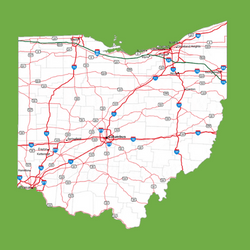
Is Hitchhiking Legal in Ohio?
Hitchhiking is legal in Ohio.
Ohio Hitchhiking Laws
- 4511.51 Hitching of Rides
- Soliciting a ride from the driver of any vehicle while on a roadway outside a safety zone is forbidden. Standing on a highway to solicit business is also forbidden. A person shall not hang onto or ride on the outside or the rear end of any motor vehicle moving on a roadway. Drivers shall not permit any person, other than workers performing maintenance or construction duties, to ride in the cargo storage area or on a tailgate while the tailgate is unlatched.
- 4511.01 Definitions
- (EE) “Roadway” means the improved surface ordinarily used for vehicular travel. Excludes the shoulder.
Oklahoma
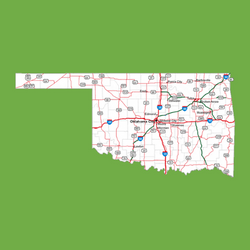
Is Hitchhiking Legal in Oklahoma?
Hitchhiking is legal in Oklahoma.
Oklahoma Hitchhiking Laws
- 47-11-1401-D1
- D. It shall be unlawful for any person to travel a turnpike on foot except to leave or service a disabled vehicle, or for any person to hitchhike on a turnpike.
Oregon
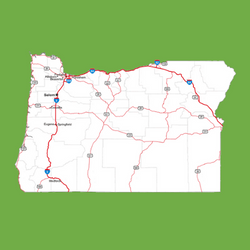
Is Hitchhiking Legal in Oregon?
Hitchhiking is legal in Oregon.
Oregon Hitchhiking Laws
- 814.080 Unlawful hitchhiking
- (1) A person commits the offense of unlawful hitchhiking if the person is on a roadway for the purpose of soliciting a ride.
- (2) The offense described in this section, unlawful hitchhiking, is a Class D traffic violation.
- Title 59. Chapter 801. General Provisions and Definitions for Oregon Vehicle Code
- 801.450 “Roadway” means the portion of a highway that is improved, designed or ordinarily used for vehicular travel, exclusive of the shoulder.
Pennsylvania
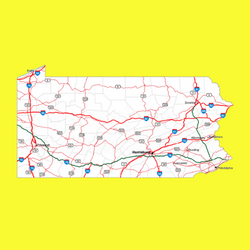
Is Hitchhiking Legal in Pennsylvania?
Hitchhiking is illegal in Pennsylvania on any part of the Turnpike. It is also illegal to stand on the roadway while soliciting a ride.
Pennsylvania Hitchhiking Laws
- 75 Pa. Cons. Stat. 3545 – Pedestrians soliciting rides or business
- No person shall
- (1) Stand on a roadway for the purpose of soliciting a ride.
- Roadway—That portion of a highway improved, designed or ordinarily used for vehicular travel, exclusive of the sidewalk, berm or shoulder even though the sidewalk, berm or shoulder is used by pedalcycles.
- No person shall
- TURNPIKE TRAFFIC REGULATIONS
- 601.11. Hitchhiking. The solicitation for a ride, commonly known as “hitchhiking,” is prohibited, and stopping or allowing a vehicle to be standing while hitchhikers board is also prohibited.
Rhode Island
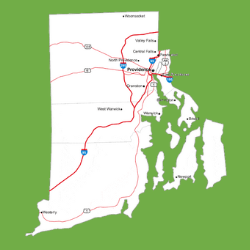
Is Hitchhiking Legal in Rhode Island?
Hitchhiking is legal in Rhode Island.
Rhode Island Hitchhiking Laws
- Chapter 18 Pedestrians
- Section 12 Hitchhiking in road. No person shall stand in a roadway for the purpose of soliciting a ride from the driver of any vehicle. Violations of this section are subject to fines enumerated in § 31-41.1-4.
- Chapter 1 Definitions and General Code Provisions
- (h) “Roadway” means that portion of a highway improved, designed, or ordinarily used for vehicular travel, excluding the sidewalk, berm, or shoulder even when used by persons riding bicycles.
South Carolina
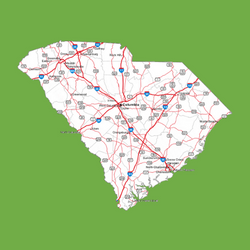
Is Hitchhiking Legal in South Carolina?
Hitchhiking is legal in South Carolina.
South Carolina Hitchhiking Laws
- Article 25 Pedestrians; Rights and duties thereof
- Section 56 5 3180. Pedestrians soliciting rides or business.
- (a) No person shall stand in a roadway for the purpose of soliciting a ride.
- Section 56 5 3180. Pedestrians soliciting rides or business.
- Definitions
- Road – That part of the trafficway which includes both the roadway and any shoulder alongside the roadway.
South Dakota
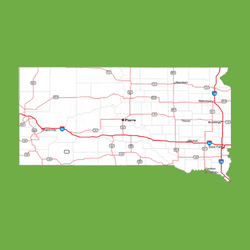
Is Hitchhiking Legal in South Dakota?
Hitchhiking is legal in South Dakota.
South Dakota Hitchhiking Laws
Hitchhiking laws for the state of South Dakota do not exist however local laws may exist.
Tennessee

Is Hitchhiking Legal in Tennessee?
Hitchhiking is legal in Tennessee.
Tennessee Hitchhiking Laws
- 55-8-139. Pedestrians soliciting rides or business.
- (a) No person shall stand in a roadway for the purpose of soliciting a ride or employment from the occupant of any vehicle.
- Department Policy: State of Tennessee Department of Transportation Definitions:
- Roadway – the portion of a highway intended for vehicular use.
Tennessee State Parks
- 0400-2-2-.04. BEGGING AND SOLICITING.
- (2) Hitchhiking or the soliciting of transportation is prohibited.
Texas

Is Hitchhiking Legal in Texas?
Hitchhiking is illegal in Texas.
Texas Hitchhiking Laws
- Chapter 552.007. SOLICITATION BY PEDESTRIANS.
- (a) A person may not stand in a roadway to solicit a ride, contribution, employment, or business from an occupant of a vehicle, except that a person may stand in a roadway to solicit a charitable contribution if authorized to do so by the local authority having jurisdiction over the roadway.
- Chapter 552.0071
- For purposes of a solicitation under Subsection (a), a roadway is defined to include the roadbed, shoulder, median, curbs, safety zones, sidewalks, and utility easements located adjacent to or near the roadway.
Utah
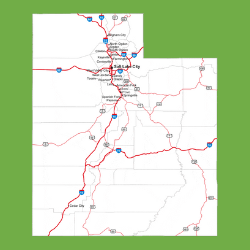
Is Hitchhiking Legal in Utah?
Hitchhiking is legal in Utah. Prior to 2018, it was considered illegal but that law has since been updated and no longer includes soliciting a ride under prohibited activities. Just be sure to use the sidewalk when available and don’t impede traffic.
Utah Hitchhiking Laws
41-6a-1009. Use of roadway by pedestrians — Prohibited activities.
- (1) Where there is a sidewalk provided and its use is practicable, a pedestrian may not walk along or on an adjacent roadway.
- (2) Where a sidewalk is not provided, a pedestrian walking along or on a highway shall walk only on the shoulder, as far as practicable from the edge of the roadway.
- (3) Where a sidewalk or a shoulder is not available, a pedestrian walking along or on a highway shall:
- (a) walk as near as practicable to the outside edge of the roadway; and
- (b) if on a two-way roadway, walk only on the left side of the roadway facing traffic.
- (4)
- (a) An individual may not impede or block traffic within any of the following:
- (i) an interstate system, as defined in Section 72-1-102;
- (ii) a freeway, as defined in Section 41-6a-102;
- (iii) a state highway, as defined in Title 72, Chapter 4, Designation of State Highways Act;
- (iv) a state route, or “SR,” as defined in Section 72-1-102; or
- (v) a highway, as defined in Section 72-1-102, that:
- (A) is paved and has a speed limit of 35 miles per hour or higher;
- (B) has a median, whether elevated or flat; or
- (C) has a fixed guideway as defined in Section 59-12-102 or any other railway that shares the highway right-of-way.
- (b) The locations described in Subsection (4)(a) include:
- (i) shoulder areas, as defined in Section 41-6a-102;
- (ii) on-ramps;
- (iii) off-ramps; and
- (iv) an area between the roadways of a divided highway, as defined in Section 41-6a-102.
- (c) The locations described in Subsection (4)(a) do not include sidewalks, as defined in Section 41-6a-102.
- (d) Conduct that may impede or block traffic includes:
- (i) while a pedestrian, accepting, transacting, exchanging, or otherwise taking possession or control of money or property from a person within a motor vehicle while that motor vehicle is within an area described in Subsection (4)(a); or
- (ii) while a driver or passenger of a motor vehicle within an area described in Subsection (4)(a), accepting, transacting, exchanging, or otherwise taking possession or control of money or property from a pedestrian.
- (a) An individual may not impede or block traffic within any of the following:
Vermont
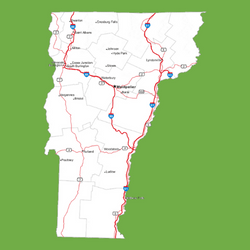
Is Hitchhiking Legal in Vermont?
Hitchhiking is legal in Vermont.
Vermont Hitchhiking Laws
- 23 V.S.A. 1157. Pedestrians soliciting rides, or business.
- (a) No person shall stand in a roadway for the purpose of soliciting a ride, or to solicit from or sell to an occupant of any vehicle.
- 23 V.S.A. 4. Definitions
- (32) “Roadway” is that portion of a highway improved, designed or ordinarily used for vehicular traffic, exclusive of the shoulder.
Virginia

Is Hitchhiking Legal in Virginia?
Hitchhiking is legal in Virginia.
Virginia Hitchhiking Laws
- 46.2-929. Pedestrians soliciting rides.
- Pedestrians shall not stand or stop in any roadway for the purpose of soliciting rides.
- 46.2-100. Definitions.
- “Roadway” means that portion of a highway improved, designed, or ordinarily used for vehicular travel, exclusive of the shoulder.
Norfolk, Virginia
- Sec. 25-631. Hitchhiking.
- No pedestrian shall stand or stop in any roadway for the purpose of soliciting rides.
Washington
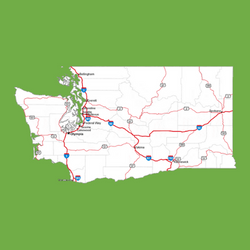
Is Hitchhiking Legal in Washington?
Hitchhiking is legal in Washington
Washington Hitchhiking Laws
- Chapter 61
- RCW 46.61.255 Pedestrians soliciting rides or business.
- (1) No person shall stand in or on a public roadway or alongside thereof at any place where a motor vehicle cannot safely stop off the main traveled portion thereof for the purpose of soliciting a ride for himself or herself or for another from the occupant of any vehicle.
- RCW 46.61.255 Pedestrians soliciting rides or business.
- Chapter 4 Definitions
- RCW 46.04.500
- “Roadway” means that portion of a highway improved, designed, or ordinarily used for vehicular travel, exclusive of the sidewalk or shoulder even though such sidewalk or shoulder is used by persons riding bicycles.
- RCW 46.04.500
West Virginia
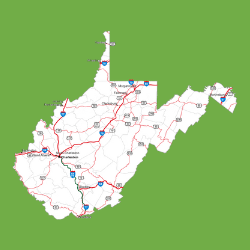
Is Hitchhiking Legal in West Virginia?
Hitchhiking is legal in West Virginia.
West Virginia Hitchhiking Laws
- 17C-10-6. Pedestrians on roadways; soliciting rides.
- (c) No person shall stand in a roadway for the purpose of soliciting a ride from the driver of any vehicle.
- 17C-1-37. Roadway.
- “Roadway” means that portion of a highway improved, designed, or ordinarily used for vehicular travel, exclusive of the berm or shoulder.
Wisconsin
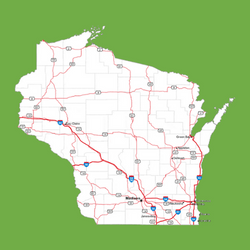
Is Hitchhiking Legal in Wisconsin?
Hitchhiking is legal in Wisconsin.
Wisconsin Hitchhiking Laws
- 346.29 When standing or loitering in roadway or highway prohibited.
- (1) No person shall be on a roadway for the purpose of soliciting a ride from the operator of any vehicle other than a public passenger vehicle.
- 346.02 Applicability of chapter.
- (8) Applicability to pedestrian ways
- (a) All of the applicable provisions of this chapter pertaining to highways, streets, alleys, roadways, and sidewalks also apply to pedestrian ways. A pedestrian way means a walk designated for the use of pedestrian travel
- (8) Applicability to pedestrian ways
- CHAPTER 340 VEHICLES — GENERAL PROVISIONS 340.01 Words and phrases defined.
- (54) ”Roadway” means that portion of a highway between the regularly established curb lines or that portion which is improved, designed or ordinarily used for vehicular travel, excluding the berm or shoulder.
Wyoming
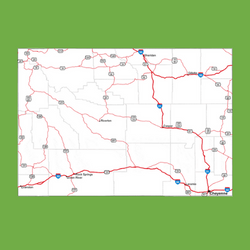
Is Hitchhiking Legal in Wyoming?
Hitchhiking is legal in Wyoming except for in the city of Evanston, Wyoming where hitchhiking is illegal.
Wyoming Hitchhiking Laws
- 31-5-605. Walking along roadways or highways.
- (a) Where a sidewalk is provided and its use is practicable it is unlawful for any pedestrian to walk along and upon an adjacent roadway.
- (b) Where sidewalks are not provided any pedestrian walking along and upon a highway shall, when practicable, walk only on the left side of the roadway or its shoulder facing traffic which may approach from the opposite direction as far as practicable from the edge of the roadway.
- (c) Except as otherwise provided in this act, any pedestrian upon a roadway shall yield the right-of-way to all vehicles upon the roadway.
- 31-5-606. Soliciting on streets and highways.
- (a) No person shall be on a highway for the purpose of soliciting employment, business or contributions from the occupant of any vehicle.
- (b) No person shall stand on or in proximity to a street or highway for the purpose of soliciting the watching or guarding of any vehicle while parked or about to be parked on a street or highway.
Evanston, Wyoming
- 12-107 Soliciting rides
- A. No person shall stand on a street for the purpose of soliciting a ride, employment or business from the occupant of any vehicle.
- B. No person shall stand on or in proximity to a street for the purpose of soliciting the watching or guarding of any vehicle while parked or about to be parked on a street or highway.
Federal Hitchhiking Laws
According to the Code of Federal Regulations, it is illegal to hitchhike in federally protected parks, forests, and public property unless it is expressively stated otherwise.
- Title 36—Parks, Forests, and Public Property
- §4.31 Hitchhiking.
- Hitchhiking or soliciting transportation is prohibited except in designated areas and under conditions established by the superintendent.
- §4.31 Hitchhiking.
Grand Teton National Park
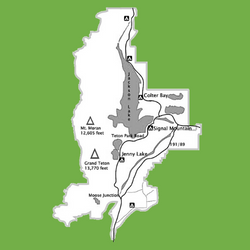
Is Hitchhiking Legal in Grand Teton National Park?
It is legal to hitchhike in Grand Teton National Park unless you are near an entrance station, visitor center, or office building.
While hitchhiking you must stay safe by wearing bright clothing at night, don’t stand on the paved roadway, and don’t use a sign larger than 2ft x 2ft.
Grand Teton National Park Hitchhiking Laws
Hitchhiking laws in Grand Teton National Park are outlined in the Superintendent’s Compendium for Grand Teton National Park & John D. Rockefeller, Jr. Memorial Parkway.
- §4.31 – Hitchhiking.
- Hitchhiking or reasonably soliciting transportation shall be permitted within Grand Teton National Park and John D. Rockefeller, Jr. Memorial Parkway EXCEPT:
- Within two tenths of a mile (0.2mi) of an entrance station
- Within 200 feet of a park service office building or visitor center.
- While holding or having a sign that is larger than 2’x2’ in size.
- The hitchhiker must stay off the driving lane of a paved roadway that has a white fog line and off the surface of a paved roadway that does not have a white fog line, though a hitchhiker may stand on pavement in a paved pullout.
- Where vehicles may not safely pull off the main traffic lane into a pullout or safely onto the shoulder to allow for the passengers to be received safely.
- During the hours of darkness unless the hitchhiker is wearing bright (preferably reflectively enhanced) clothing.
- When hitchhiking behavior is deemed unsafe or a nuisance by a commissioned law enforcement ranger.
- Hitchhiking or reasonably soliciting transportation shall be permitted within Grand Teton National Park and John D. Rockefeller, Jr. Memorial Parkway EXCEPT:
Yellowstone National Park
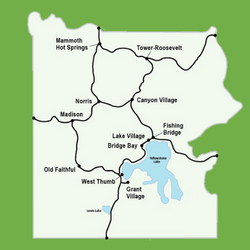
Is Hitchhiking Legal in Yellowstone National Park?
It is legal to hitchhike in Yellowstone National Park unless you are near an entrance station, school, visitor center, office building, or designated residential / government areas.
While hitchhiking you must stay safe by wearing bright clothing at night, don’t stand on the paved roadway, and don’t use a sign larger than 2ft x 2ft.
Yellowstone National Park Hitchhiking Laws
Hitchhiking laws in Yellowstone National Park are outlined in the Superintendent’s Compendium for Yellowstone National Park.
- §4.31 – Hitchhiking.
- Designated areas and conditions for hitchhiking or soliciting transportation in park areas:
- SC1. All areas within the park are permitted for hitchhiking or soliciting transport except:
- (a) Within 0.2 miles of park entrance stations.
- (b) Within 200 feet schools, businesses, NPS office buildings, or visitor centers.
- (c) In signed residential or government areas.
- (d) In an area where vehicles may not safely pull off a park road fully onto the road’s shoulder or into a pull out.
- SC2. Persons hitchhiking or soliciting transport are prohibited from the following:
- (a) Holding or having a sign larger than 2 feet x 2 feet.
- (b) Standing on the paved surface of a park road, except for clearly defined pull outs.
- (c) Wearing dark colored clothing during hours of darkness.
- (d) Being under the influence of alcohol or an intoxicating substance.
- (e) Being unsafe or causing a nuisance.
- SC1. All areas within the park are permitted for hitchhiking or soliciting transport except:
- Designated areas and conditions for hitchhiking or soliciting transportation in park areas:
- What to Wear in Cancun by Month & Activity (And Not!) - March 13, 2023
- What to Wear in New York by Month & Activity (And Not!) - March 13, 2023
- What to Wear in Morocco by Month & Activity (And Not!) - March 13, 2023

